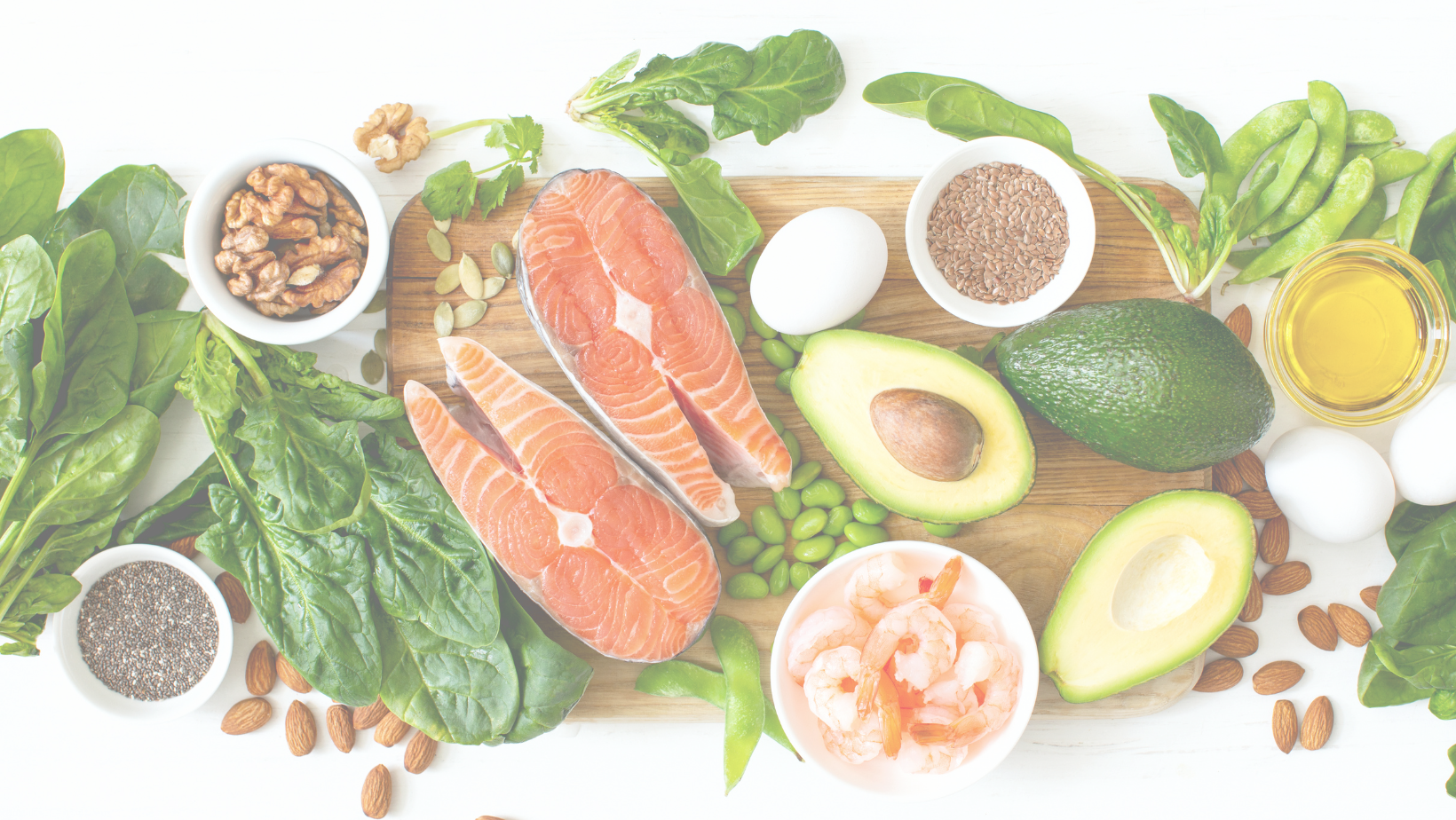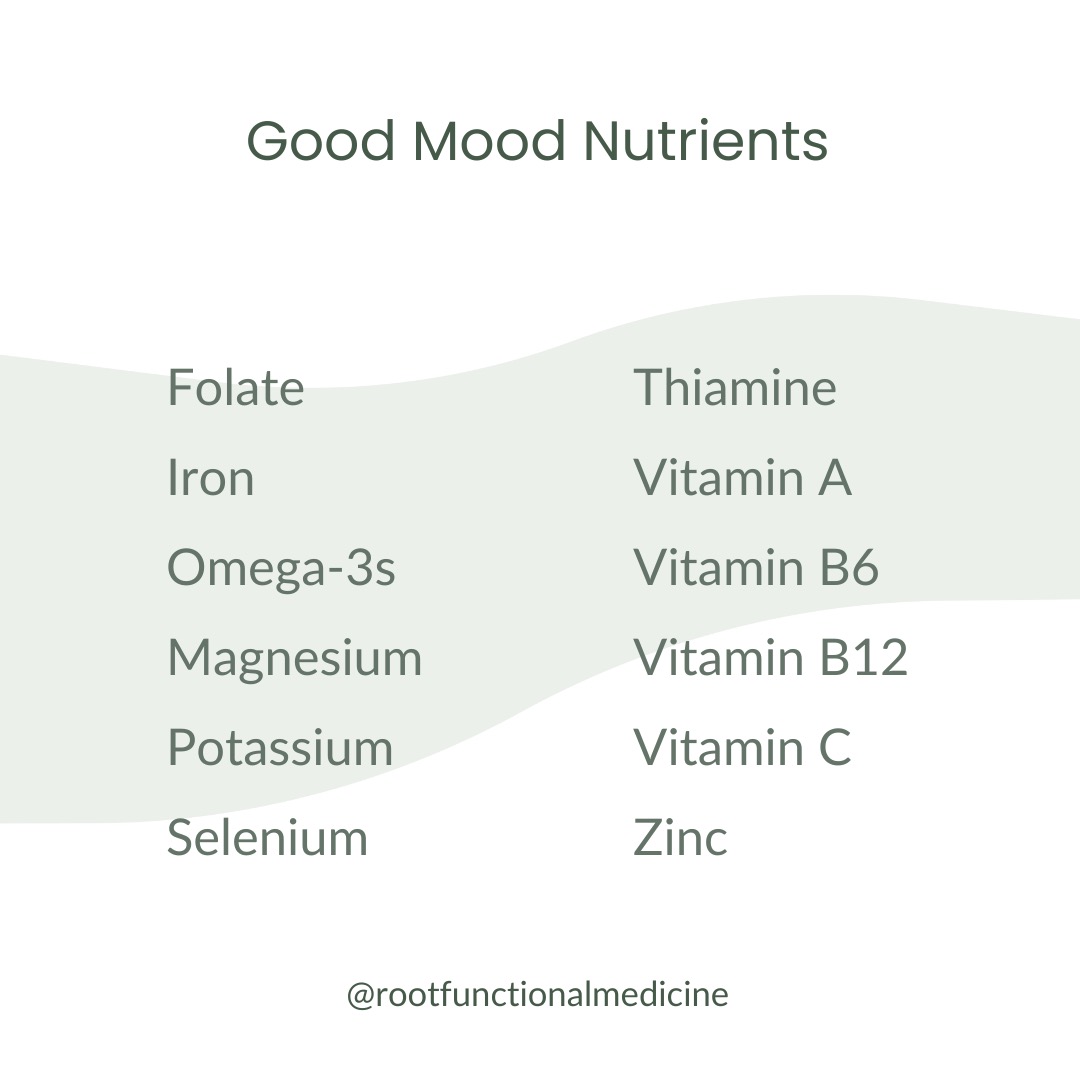
Good Food Good Mood
The foods you eat play an important role in supporting a healthy and happy mood.
This article explains how food affects your mood, which mood-enhancing foods we recommend, and how to best individualize your “good food, good mood” diet.
How Does Food Affect Your Mood?
Your brain is a complex organ. It communicates with the rest of your body and receives feedback communication from other organs, like the gut.
Put simply, nutritious food benefits your mood by supporting healthy communication in the brain and reducing chronic inflammation. For instance, certain nutrients increase the production of a protein in the brain called Brain-Derived Neurotrophic Factor (BDNF).
Secondly, chronic inflammation is a major root cause of mood disorders, like depression (2). So, the diet pattern that most supports a good mood is rich in anti-inflammatory foods!
What Nutrients Support a Good Mood?
There are twelve nutrients that seem to play the biggest role in benefiting mood disorders, according to a large study published in 2018 (3).

One dietary pattern seems to most effectively encompass all of these nutrients. The Mediterranean diet is an anti-inflammatory eating pattern that has been found to improve mood disorders like depression or anxiety (4, 5, 6). A Mediterranean diet is rich in fruits, vegetables, nuts, seeds, legumes, and seafood.
Seafood
Seafood is one of the best food categories for a good mood thanks to rich amounts of omega-3 fats, vitamin B12, selenium, and zinc.
Omega-3 fats have loads of research backing them as a brain-boosting and mood-enhancing nutrient. Fatty fish are particularly rich in two omega-3 fats commonly known as EPA and DHA (i.e. fish oil).
The best sources of EPA and DHA with the lowest amounts of mercury include salmon, mackerel, anchovies, herring, and sardines. These types of fish are also rich in selenium and vitamin B12 to further support a good mood!
Other types of seafood, like oysters and mussels, are particularly rich in zinc. In fact, six cooked oysters provide over 600 percent of your daily zinc requirements (7).
We recommend including low-mercury seafood into your meals at least two times per week, if not more!
Leafy Greens
Leafy greens—like spinach, kale, chard, and bok choy—are rich sources of good mood nutrients like folate, vitamin A, and vitamin C. Both vitamins A and C have antioxidant properties to fight off free radicals, or molecules that can harm your body and cause oxidative stress. This is important because oxidative stress may be another root cause of mood disorders, like depression (8).
Additionally, the folate in leafy greens supports methylation and the production of neurotransmitters, like serotonin, to improve your mood (9).
Here are a few different ways to eat more leafy greens:
- Add bok choy to an Asian stir-fry
- Throw spinach into a morning smoothie
- Mix chopped spinach into an egg omelet
- Add spinach to homemade pesto sauce
- Roast some kale chips
- Use chard leaves to wrap up sandwich contents
Cruciferous Vegetables
Cruciferous vegetables are a diverse group of veggies like broccoli, cauliflower, Brussel sprouts, and cabbage.
Crucifers are packed with nutrients like folate and vitamin C. However, the mood-enhancing benefit of cruciferous veggies is also due to their role in estrogen detoxification. Crucifers are rich in phytochemicals (like DIM) that help your liver metabolize estrogen. This is key for a good mood because too much estrogen may lead to symptoms like depression or anxiety (10).
Use cauliflower rice in your Asian dishes, add chopped cabbage to tacos, or shred Brussel sprouts as an alternative salad base. You can also use foods like broccoli slaw with tuna salad or in recipes like “egg roll in a bowl.”
Nuts and Seeds
We include nuts and seeds in our good food, good mood diet because they contain high amounts of magnesium, zinc, and selenium.
Zinc and selenium are particularly important in maintaining optimal thyroid health, a butterfly-shaped gland in your neck. The thyroid has many jobs in the body, one of which is balancing your overall mood. Eating sufficient amounts of selenium and zinc ensures that your body makes enough active thyroid hormone to support a good mood. Did you know? Just one brazil nut per day meets your daily requirements for selenium!
Magnesium also plays a critical role in supporting a good mood by promoting hormone balance and the production of brain chemicals like serotonin and GABA (11).
Here are a few ways to eat more nuts and seeds:
- Make breakfast quinoa with slivered almonds and pumpkin seeds
- Throw a tablespoon of ground flaxseed into your smoothie
- Spread your nut butter of choice on apple slices for a filling snack
- Try a recipe for nut-crusted fish or chicken
- Sprinkle walnuts onto your salad for a satisfying crunch
Mental Health Lab Panel
Nutrient status is often overlooked when it comes to mental health, but it has a significant impact on mood and cognitive function. Root's Mental Health Panel tests high-sensitivity C-reactive protein (hs-CRP), vitamin D, omega-6/3 levels, vitamin B12, and RBC magnesium. This allows you to make changes with diet and supplementation based on data, not just guessing. All results include insights from Root doctors.
Mental Health Panel
RBC Magnesium Level , hs CRP, OmegaCheck (Omega 3 and 6 levels), Vitamin D level, Vitamin B12 level
$95.00
Balance Your Blood Sugar
If you are constantly riding a blood sugar rollercoaster, you may experience mood disturbances from frequent sugar cravings, fatigue after meals, weight gain or difficulty losing weight, and constant hunger. We suggest following the Root Plate™ and including a good source of protein, fat, and fiber at each meal to keep your blood sugar stable.

What Foods Should I Avoid?
Reducing highly processed foods—like commercial baked goods, sugar-sweetened beverages, and fast food—can also improve your overall mood.
However, instead of focusing on the foods you must eliminate or reduce from your diet, we recommend focusing on all the colorful, wholesome foods you can ADD to your plate! By eating more fruits, vegetables, legumes, nuts, seeds, and seafood to your diet, you will naturally eat less of the highly-processed food items.
Individualizing Your “Good Food, Good Mood” Diet
In this article, we covered the best foods for a healthy and happy mood: seafood, leafy greens, cruciferous vegetables, and nuts/seeds. While these foods benefit most people, we recognize that everyone’s body is different! If you're looking for a more personalized approach, you might be interested in our new Mental Health Lab panel, which includes insights into key markers like nutrient levels, inflammation, and stress hormones. These labs can help uncover potential root causes affecting your mood and provide actionable steps toward feeling your best.
A “food and mood journal” helps you determine which foods make you feel great and not-so-great. In the journal, loosely record your meals and snacks for the day. But most importantly, record how you are feeling (mentally and physically) before and after each meal. This way, you adjust your diet to include more foods that make you feel great every day.
We love that food can support our overall mood each day. However, avoid overly-restrictive diets and remember that factors like adequate sleep, stress reduction and social connection also support a healthy and happy mood.
Mental Health Panel
RBC Magnesium Level , hs CRP, OmegaCheck (Omega 3 and 6 levels), Vitamin D level, Vitamin B12 level
$95.00
Related Articles

Zinc for PCOS
Taking zinc for PCOS may help reduce common symptoms of this condition like unwanted hair growth and/or hair loss, acne, high blood sugar, and more.

IBS and PCOS
An estimated 30 to 40 percent of women with PCOS also have IBS (2, 3). IBS is more common in PCOS than the general population because these two conditions share one major root cause: dysbiosis.
